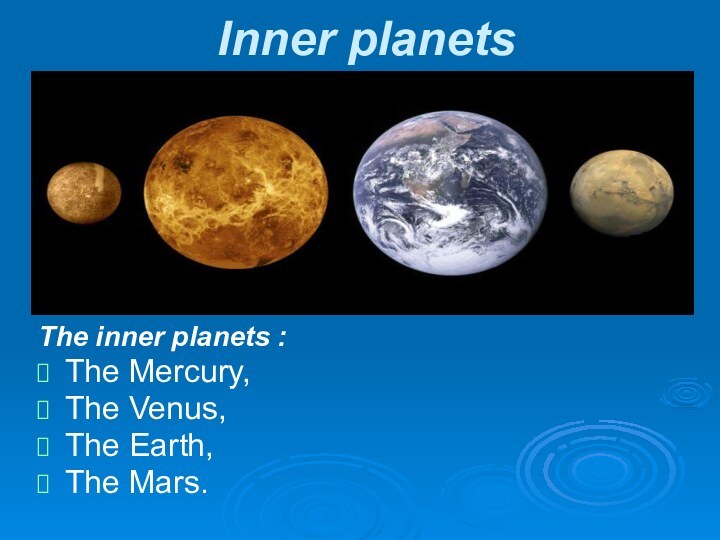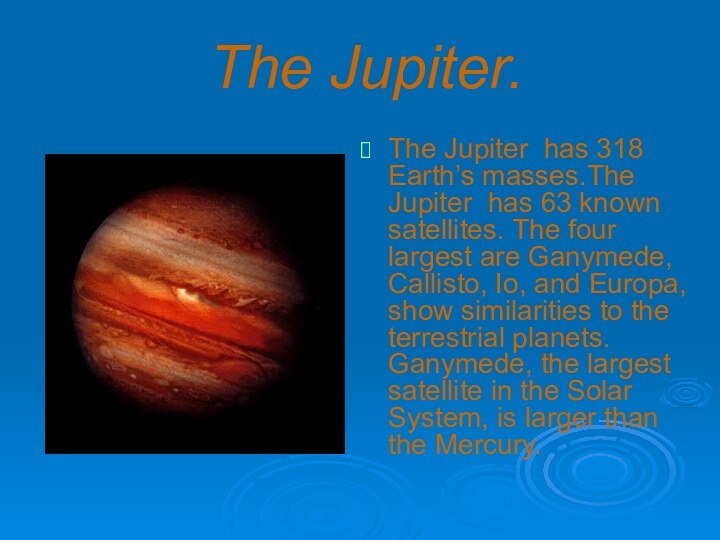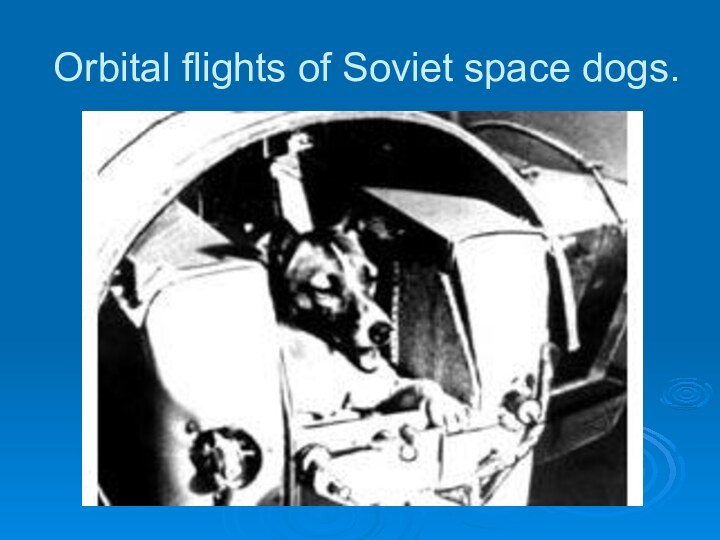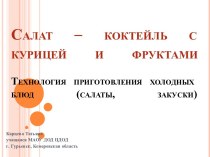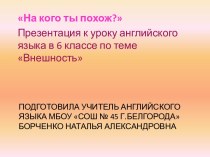Слайд 3
Inner planets
The inner planets :
The Mercury,
The Venus,
The Earth,
The
Mars.
Слайд 4
The Mercury.
It is the closest planet to the
Sun and the smallest planet (0.055 Earth masses). The
Mercury has no natural satellites.
Слайд 5
The Venus.
It is close in size to the
Earth, (0.815 Earth masses). It is much drier than
the Earth. The Venus has no natural satellites. It is the hottest planet, with surface temperatures over 400 ºC.
Слайд 6
The Earth.
It is the largest and densest of
the inner planets and is the only place in
the universe where live is known to exist. The Earth's atmosphere is radically different from those of the other planets, having been altered by the presence of life to contain 21% free oxygen.
Слайд 7
The Mars.
It is smaller than the Earth and
the Venus (0.107 Earth masses). It possesses an atmosphere
of mostly carbon dioxide. The Mars has two tiny natural satellites (Deimos and Phobos) thought to be captured asteroids.
Слайд 8
Outer planets
The outer planets:
The Jupiter
The Saturn
The Uranus
The
Neptune
Слайд 9
The Jupiter.
The Jupiter has 318 Earth’s masses.The Jupiter
has 63 known satellites. The four largest are Ganymede,
Callisto, Io, and Europa, show similarities to the terrestrial planets. Ganymede, the largest satellite in the Solar System, is larger than the Mercury.
Слайд 10
The Saturn.
The Saturn is distinguished by it’s extensivering
system. The Saturn has 60% of the Jupiter's volume.
The Saturn has 60 confirmed satellites. The Titan is larger than the Mercury and the only satellite in the Solar System with a substantial atmosphere.
Слайд 11
The Uranus.
The Uranus is the lightest of the
outer planets. Uniquely among the planets, it orbits the
Sun on it’s side. The Uranus has 27 known satellites, the largest ones being the Titania, theOberon, the Umbriel, the Arieland, the Miranda
Слайд 12
The Neptune.
The Neptune though slightly smaller than the
Uranus, is more massive (equivalent to 17 Earths) and
therefore more dense. It radiates more internal heat, but not as much as the Jupiter or the Saturn. The Neptune has 13 known satellites. The largest – the Triton.
Слайд 14
Comets are small Solar System bodies, typically only
a few kilometres across, composed largely of volatile ices.
Short-period comets have orbits lasting less than two hundred years. Long-period comets have orbits lasting thousands of years. Old comets that have had most of their volatiles driven out by solar warming are often categorised as asteroids.
Слайд 16
The Space Transportation System, or The Space Shuttle
is a spacecraft operated by NASA for orbital human
spaceflight missions. Major missions have included launching numerous satellites and interplanetary probes, conducting space science experiments, and servicing and construction of space stations. The system is scheduled to be retired from service in 2010 after 134 launches.
Слайд 18
Sputnik 1 was the first Earth-orbiting artificial satellite.
It was launched into an elliptical low earth orbit
by the Soviet Union on 4 October 1957, and was the first in a series of satellites collectively known as the Sputnik program. Sputnik-1 was launched during the International Geophysical Year from Site No.1, at the 5th Tyuratam range, in Kazakh SSR (now at the Baikonur Cosmodrome).
Слайд 19
Orbital flights of Soviet space dogs.
Слайд 20
The first animal launched into orbit.
Слайд 21
Laika was a Soviet space dog who became
the first animal to orbit the Earth and the
first orbital death. Laika died a few hours after launch, presumably from stress and overheating, probably due to a malfunction in the thermal control system. On April 11, 2008, Russian officials unveiled a monument to Laika. A small monument in her honor was built near the military research facility in Moscow which prepared Laika's flight to space.


